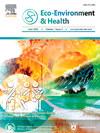环境空气污染暴露与中国人脑血管疾病的关系:一项基于颅磁共振成像的研究
引用次数: 0
摘要
脑血管病(CSVD)是一种与脑卒中和痴呆密切相关的慢性进行性血管疾病,主要通过颅脑磁共振成像(MRI)识别和诊断。鉴于空气污染与CSVD之间的关系证据有限,本研究旨在探讨多种空气污染物暴露与CSVD风险之间的联系。符合条件的受试者及其头颅MRI数据来源于基于开滦研究的多模态医学影像学研究,共1216名受试者。使用有序和二元logistic回归模型来评估空气污染暴露与CSVD神经影像学标志物之间的关系。对于检查年度空气污染物暴露的每个四分位数范围增加,PM2.5增加的白质高强度负担的比值比和95%置信区间分别为1.45 (1.15,1.84),1.72 (1.27,2.34),1.26 (1.05,1.51)SO2, 1.52 (1.16, 2.00) NO2和1.63 (1.26,2.13)CO。即使使用不同暴露窗口的空气污染拟合模型,结果仍保持一致。此外,对CSVD总负担的估计效应大小分别为PM2.5 1.20(1.01, 1.43)、PM10 1.39(1.12, 1.74)、NO2 1.26(1.03, 1.53)和CO 1.30(1.08, 1.58)。这些研究结果表明,空气污染物暴露与中国人群CSVD神经成像标志物之间存在正相关,揭示了控制环境污染物对保护人群免受脑血管损伤的重要性。本文章由计算机程序翻译,如有差异,请以英文原文为准。

Ambient air pollution exposure in relation to cerebral small vessel disease in Chinese population: A cranial magnetic resonance imaging-based study
Cerebral small vessel disease (CSVD), a chronic and progressive vascular disorder closely associated with stroke and dementia, is primarily identified and diagnosed in cranial magnetic resonance imaging (MRI). Given the limited evidence on the relationship between air pollution and CSVD, this study aimed to investigate the links between multiple air pollutants exposure and CSVD risk. Eligible subjects and their cranial MRI data were obtained from the Multi-modality Medical Imaging Study Based on Kailuan Study, totaling 1216 participants. Ordinal and binary logistic regression models were utilized to evaluate the associations between air pollution exposure and the neuroimaging markers of CSVD. For each interquartile range increase in air pollutant exposure during the examination year, the odds ratios and 95% confidence intervals of the increased white matter hyperintensity burden were 1.45 (1.15, 1.84) for PM2.5, 1.72 (1.27, 2.34) for PM10, 1.26 (1.05, 1.51) for SO2, 1.52 (1.16, 2.00) for NO2, and 1.63 (1.26, 2.13) for CO. The results remained consistent even when the model was fitted using air pollution from different exposure windows. Furthermore, the estimated effect sizes for the total burden of CSVD were 1.20 (1.01, 1.43) for PM2.5, 1.39 (1.12, 1.74) for PM10, 1.26 (1.03, 1.53) for NO2, and 1.30 (1.08, 1.58) for CO. These findings suggest that a positive link between air pollutants exposure and neuroimaging markers of CSVD in the Chinese population, revealing the importance of controlling environmental pollutants to protect the population against cerebral small vessel damage.
求助全文
通过发布文献求助,成功后即可免费获取论文全文。
去求助
来源期刊

Eco-Environment & Health
环境科学与生态学-生态、环境与健康
CiteScore
11.00
自引率
0.00%
发文量
18
审稿时长
22 days
期刊介绍:
Eco-Environment & Health (EEH) is an international and multidisciplinary peer-reviewed journal designed for publications on the frontiers of the ecology, environment and health as well as their related disciplines. EEH focuses on the concept of “One Health” to promote green and sustainable development, dealing with the interactions among ecology, environment and health, and the underlying mechanisms and interventions. Our mission is to be one of the most important flagship journals in the field of environmental health.
Scopes
EEH covers a variety of research areas, including but not limited to ecology and biodiversity conservation, environmental behaviors and bioprocesses of emerging contaminants, human exposure and health effects, and evaluation, management and regulation of environmental risks. The key topics of EEH include:
1) Ecology and Biodiversity Conservation
Biodiversity
Ecological restoration
Ecological safety
Protected area
2) Environmental and Biological Fate of Emerging Contaminants
Environmental behaviors
Environmental processes
Environmental microbiology
3) Human Exposure and Health Effects
Environmental toxicology
Environmental epidemiology
Environmental health risk
Food safety
4) Evaluation, Management and Regulation of Environmental Risks
Chemical safety
Environmental policy
Health policy
Health economics
Environmental remediation
 求助内容:
求助内容: 应助结果提醒方式:
应助结果提醒方式:


